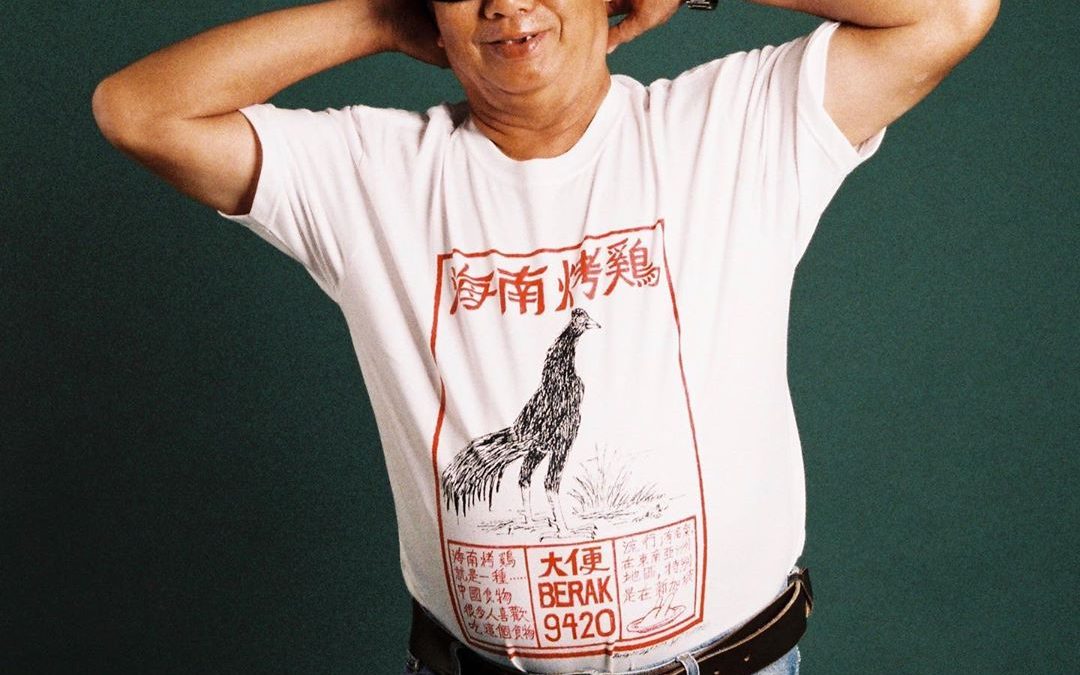At the end of 2019, when I was filming a live performance of Gabber Modus Operandi in Jakarta, Indonesia, vocalist Ican Harem took out from his luggage a T-shirt with a vintage drawing – a Chinese dragon entrenched on an ancient Chinese building. Below the image is the name of Gabber Modus Operandi and a line of handwritten Chinese – “空谈模型运行”. Me, a Chinese filmmaker, actually couldn’t understand what this line means, but inherently knew that if I was to enter Gabber Modus Operandi into a online translator, this would be the result! Ican Harem said that the designer of this T-shirt is Supomo, an old and highly regarded Indonesian artist. When I looked to get to the bottom of this, Ican was already busy with other things.

A few months later, Instagram finally recommended Supomo ’s instagram account to me with an algorithm. When I clicked inside the old gentleman’s account, a door to a new world opened to me.
This account is called Senkanji, and is full of Chinese hand-painted works by Mr. Supomo. It can be seen that the young Indonesians are also fascinated by Mr. Supomo’s vintage painting style. They place orders and give him a sentence in Indonesian Bahasa. He then translates this sentence into Chinese and then hand-draws it in with various sketches. Young Indonesians then print these designs on their T-shirts and wear them proudly. But the difference is that I was even more impressed by Mr. Supomo’s less than fluent Chinese translation. I don’t want to describe these translations as “nothing but bullshit”. That ’s too arrogant. After all, most Chinese people ’s foreign language skills are probably even worse. In fact, some of the translations of the old man are still very accurate, such as “大便”(shit) “肥胖的小猫”(fat little cat)“海南鸡饭”(Hainan chicken rice) “努力运动,虽然不瘦” (work out hard, although you are not thin) and so on. And these poorly translated translations seem to reveal a sense of Zen, and subtle feelings that the creative director can’t even think of, such as “流行印尼商店,我们卖震惊”、“希望继续热闹,别人已经去到了月亮,我们还在停止处”、“杀死黑暗为黑皇帝” and so on.




I carefully checked the account of this old gentleman, clicking on each picture; there was a feeling of “lost in translation”. Finally, I got the courage to send a private letter to Mr. Supomo, saying that I wanted to interview him. The reply was from Mr. Supomo’s son Yulius, who is also the actual operator of his Instagram account. Yulius’s English is very good, but he insists on using Bahasa to answer the interview questions. I think OK, I will use Google Translate to translate his original text into English and Chinese, and then manually proofread based on this program’s translation. I don’t know how much information will be lost in this translation process, but it feels quite appropriate given the subject. Maybe it can create it’s own beauty,just like Supomo’s artwork.
Subtropical Asia: Please briefly introduce yourself:—— name, age, city of residence, and your occupation.
Mr.Supomo: My name is Supomo/Fu He Po, I was born in Indramayu on April 8th, 1955. I live in Bandung, Indonesia. I am a retired private employee, and pressently I’m a full time artist.
Do you have Chinese origin? Can you speak Chinese? Under what circumstances did you decide to use Chinese for hand painting?
Yes I am Fu Jian Ren’s descendant. I can communicate in Chinese but it is limited and up to now I am still learning. My hobby is drawing since childhood. Drawing is an activity that I do pretty much every day – as well as my way to express and entertain myself to eliminate boredom. I decided to draw calligraphy using the Chinese characters to improve my Mandarin literacy. Also, because I like and want to preserve the heritage of my ancestors.

How are these Chinese words and terms translated? To be honest, we can see that some Chinese translations are not accurate enough, but it is this inaccuracy that makes your work very humorous!
I first attended a Mandarin course in Bandung, in 2005. My teacher was Mary Yeh Chun Chen, a native of Tainan City in Taiwan. To this day I continue to develop by learning more from dictionaries & the Internet. Now that I do it all by myself, no one else corrects it, so please note that some of the translations are inaccurate.
You told us that you have been to Shanghai before. Can you tell us what brought you to Shanghai at that time, and what interesting insights did you have during that Shanghai trip?
The one who went to Shanghai was not I but my eldest son, Yulius. He traveled to Mainland China, Hong Kong & Taiwan several times for his work. He tells us that these places are advanced and exciting regions to visit.
What do you think of China? Have you ever talked to young people in Indonesia about China, and what do they think of Chinese culture?
Chinese culture is very interesting. Even though China is very modern, there are still many ancestral cultures that have been preserved until now. Mastering Mandarin is also important now, because technology & other industries from China continue to expand throughout the world.

Did you have a conventional art education? What is your creative process in general? Where do you get artistic inspiration?
All of my drawing techniques came naturally and completely without bothering with art education. The creative process comes out spontaneously – everything just flows. What’s on my mind – that’s what I put on the paper. I get inspired from everyday life.
Your work is kinda popular and considered cool among young Indonesians. Why is that in your opinion?
Maybe because art is always comes and goes in cycles. In recent years, young Indonesians have become fond of vintage design/art characters. And because my work is uniquely vintage and retro, they favor it. I never expected to be like this now. It all started when Yulius introduced my work on Instagram & Twitter in 2017.

How many painting orders do you receive each month? How much do you charge for that?
On average, I have around 3-5 orders every month. I do not set the price for each work, so that every buyer may appreciate the sincerity (pay as you wish).
Which one is your favorite among all of your works?
The most memorable one is the picture of a dragon wrapped around a Gadang house order Ican Harem (Gabber Mode Operandi). The work was printed on a T-shirt and sold very well. Ha ha ha. Then the Javanese man series holding the Rooster Sukubumi is also one of my favorites.

We see that there are Buddhist elements in your creations. Are you a Buddhist or a Muslim? How does religious belief affect your creation?
I am not a Buddhist, my religion is Protestant Christianity. I draw Buddha elements solely because of client’s wishes. My belief influences my creative process because the Lord Jesus Christ whom I trust has given me the ability to continue working and share my blessings through these drawings.

What does painting and art mean to you personally?
Art activities (painting and drawing) for me are a medium for communication. I can spread the message and freely express my expression through scribbles on paper/canvas.

Recently, has your daily life or creation been affected by the covid-19 epidemic? Is the city of Bandung where you live still being lock down?
Yes, this COVID-19 outbreak affected all aspects of life, including my artistic activities. There are a number of projects that have been put on hold and orders have declined. The city of Bandung has now loosened up the lockdown.
More art works from Mr.Supomo , click his Instagram
Follow Subtropical Asia on Instagram

